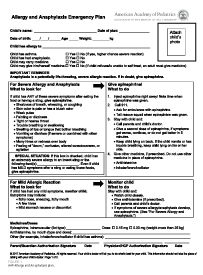The American Academy of Pediatrics (AAP) reaffirmed epinephrine as the first choice to treat severe allergic reactions. And to make certain parents, caregivers and others are ready to treat anaphylaxis, the AAP released its own version of a food allergy action plan.1
The recommendations were released in the February 13 edition of the journal Pediatrics.2
The report stresses that it is better to use epinephrine early, even if parents are not 100% sure that the symptoms are anaphylaxis (anna-fih-LACK-sis).
The symptoms of anaphylaxis may occur shortly after having contact with an allergen and can get worse quickly. Allergic reactions can vary from one time to the next. Both the types of symptoms and how serious they are can change. Anaphylaxis must be treated right away to provide the best chance for improvement and prevent serious, potentially life-threatening complications.
References
1. Sicherer, Scott H., Wang, Julie. (2017). Guidance on Completing a Written Allergy and Anaphylaxis Emergency Plan. Pediatrics.
2. Sicherer, Scott H., Simons, F. Estelle R. (2017). Epinephrine for First-aid Management of Anaphylaxis. Pediatrics.



Comments (0)